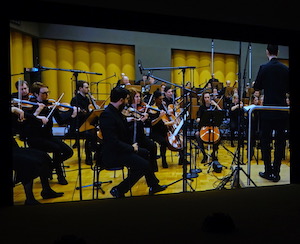Samson Young’s exhibition Real Music at Talbot Rice Gallery is the artist’s first solo exhibition in the UK and presents several bodies of work that are heavily influenced by innovative research. Young works interdisciplinary – he is both a composer and a visual artist who explores the limits of both media and creates unique experiences within the frame of a gallery space.
His collaboration with Next Generation Sound Synthesis (NESS) at the University of Edinburgh resulted in the installation Possible Music #2 that simulates the sound of hypothetical instruments in hypothetical conditions such as “a bugle sound if it was activated by the fiery breath of a dragon”. As Tessa Giblin and Charlotte Day explain in the accompanying booklet, this work makes it possible to synthesise formerly impossible sounds. The sound work is accompanied by a 3D printed brass instrument emerging from a dark blue carpet – as if rising from the sea. Overlooking this large-scale installation from the Georgian balcony is a series of works on paper titled Orchestrations, offering a glimpse into how Young uses visual strategies – whether these are drawing, text or additional materials such as plastic – to reproduce sound in silence.

The tension between absence and presence is a continued trope in Young’s work. Moving on to the next room, we find his collaboration with Cologne Flore Symphony Orchestra titled Muted Situations #22: Muted Tchaikovsky’s Fifth that shows a muted orchestra, i.e. an orchestra playing with muted instruments. The absence of sound emphasises the physical performativity of the musicians and reveals a hidden layer – the unexpected mechanical noises of the composition. This challenges the natural assumption of interconnectivity between the visual and auditive – do we still see the 5th symphony if it doesn’t sound like it?
Finally, we enter the last installation The world falls apart into facts, a personal favourite, that begins as an imitation of a wunderkammer with museum objects presented in glass vitrines – a painting by the Dutch artist Pieter Neefs, a Cantonese export painting and a miniature bridge-harp and a rgya-gling (a monastic oboe) face each other and introduce us to the story of the Chinese folk song Molihua (Jasmine Flower). Samson Young explores the dissonance in the introduction and sudden popularity of Molihua when it was introduced in Europe in the late 18th century. However, what was understood as representative of Chinese culture was in fact transcribed by the English ambassador John Barrow. Young’s two channel video offers an ironic and funny take on what tradition means and how the current version of Molihua sounds nothing like the original Tōgaku court music.
Overall, whilst Real Music is a great opportunity to see four thought-provoking new works by Samson Young, the flow between the exhibition rooms felt disjointed due to the architectural structure of the space and some of the works felt squeezed in into rooms that were not big enough for them. It still remains one of the best exhibition of the Art Festival.
- Franco Building with Jonathan Meades (BBC 4) - 28th August 2019
